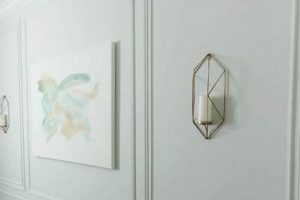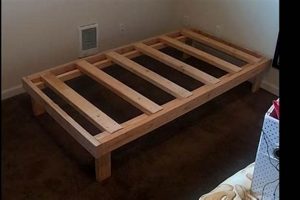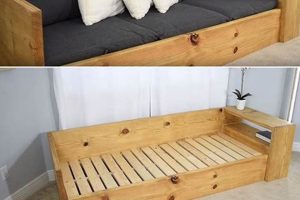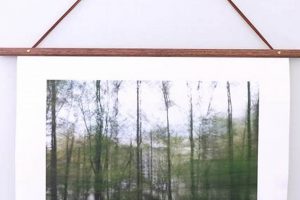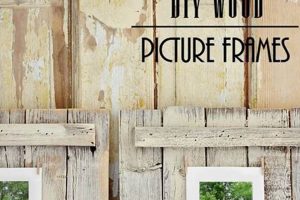The creation of a custom surround for a television screen, typically designed to mimic the appearance of a framed work of art, is gaining popularity. This involves individuals constructing a decorative border to conceal the television’s edges, thereby integrating the appliance more seamlessly into the room’s decor. An example would be building a wooden structure that attaches to the television, effectively transforming it into a picture frame when not in use.
The practice offers a cost-effective alternative to purchasing commercially available frame televisions. It allows for personalization, enabling homeowners to match the frame to their existing furniture or create a unique aesthetic. Historically, people have sought ways to conceal or disguise technology within the home; this approach reflects a contemporary manifestation of that desire, balancing entertainment needs with visual harmony. This also increases the value of a household item without spending too much money.
The following sections will explore materials commonly employed in this process, detailed construction techniques, and methods for securely attaching the frame to the television. Furthermore, various design considerations to enhance both the aesthetic appeal and functionality of the finished product will be addressed.
Construction Advice
The following guidelines provide essential insights for the successful creation of a custom surround for a television screen, aimed at achieving both aesthetic appeal and structural integrity.
Tip 1: Precise Measurement is Paramount: Accurate dimensions of the television are crucial. Prior to initiating construction, meticulously measure the television’s width, height, and depth. Account for any protruding elements, such as speakers or sensors, to ensure a snug and aesthetically pleasing fit.
Tip 2: Material Selection Considerations: The selection of appropriate materials directly impacts the project’s success. Wood, due to its versatility and workability, is a common choice. However, consider the wood’s weight, particularly for larger televisions. Lighter alternatives, such as MDF or foam board, may be preferable.
Tip 3: Secure Attachment Methodology: The method of attaching the surround to the television is critical for safety and stability. Avoid adhesives that could damage the television screen or housing. Instead, explore options such as brackets, clips, or carefully placed magnets that provide a secure yet non-permanent connection.
Tip 4: Ventilation Management: Televisions generate heat; therefore, ensure adequate ventilation within the surround. Incorporate strategically placed vents or gaps to facilitate airflow and prevent overheating, which could damage the television.
Tip 5: Cord Management Integration: Plan for efficient cord management within the surround’s design. Conceal power cables and HDMI cords to maintain a clean and uncluttered appearance. Consider incorporating channels or pathways to route cables discreetly.
Tip 6: Finishing Techniques for Aesthetic Enhancement: The final finishing touches significantly impact the surround’s visual appeal. Consider applying paint, stain, or decorative trim to match the surrounding decor. Sanding the wood thoroughly before applying any finish is crucial for a smooth and professional result.
Tip 7: Safety Precautions During Construction: Employ appropriate safety measures throughout the construction process. Wear safety glasses when cutting or sanding materials. Use caution when operating power tools and follow all manufacturer’s instructions.
Adhering to these recommendations ensures the creation of a aesthetically pleasing surround that seamlessly integrates the television into the living space while ensuring its safe and efficient operation.
With these tips in mind, proceed to the final phase of integrating the creation into your living space.
1. Precise Measurements
Accurate dimensions are paramount to the successful creation of a custom surround. The subsequent points detail the necessity of precise measurements when constructing a frame for a television.
- Television Dimensions
The television’s width, height, and depth must be measured with utmost accuracy. These measurements dictate the internal dimensions of the frame, ensuring a snug fit. Inaccurate measurements result in gaps, an unstable structure, or an inability to properly house the television within the frame.
- Bezel Width and Thickness
The intended width of the frame’s bezel impacts the overall aesthetic. Consistent bezel widths require precise cuts of the frame material. Variations in thickness affect the alignment of the frame with the television screen and potentially interfere with the television’s controls or sensors.
- Corner Angles and Joints
Accurate angle cuts are critical for creating a seamless and professional-looking frame. Precise measurements are required to ensure corners meet flush, forming perfect right angles or the desired mitered joints. Improper angles lead to visible gaps and a compromised aesthetic.
- Mounting Considerations
If the frame design incorporates a mounting system, precise measurements are required to align with existing wall mounts or to determine the appropriate placement for new mounting hardware. Misalignment can lead to instability or failure of the mounting system.
In conclusion, precise measurements serve as the foundation for a successful “diy frame tv bezel” project. Neglecting this aspect compromises both the aesthetic appeal and the structural integrity of the finished product. Careful attention to dimension ensures a professional-looking and functional addition to the living space. The failure to accurately measure any of the previously mentioned area can results in financial lost and time consuming.
2. Material Selection
Material selection directly influences the aesthetic outcome, structural integrity, and longevity of a custom television frame. The choice of material dictates the frame’s visual appearance, affecting its integration with the surrounding decor. Furthermore, the chosen material’s properties determine its resistance to warping, cracking, and other forms of deterioration, directly impacting the frame’s lifespan. For example, hardwoods such as oak or maple offer superior durability and a refined aesthetic but require specialized tools and woodworking skills for proper manipulation. Conversely, softwood like pine is more accessible and easier to work with but may lack the same level of resilience.
The weight of the selected material must also be carefully considered, especially for larger televisions. A heavy frame could strain the television’s mounting system or pose a safety hazard. Lightweight alternatives like medium-density fiberboard (MDF) or even specialized foams offer a more manageable weight profile but may require additional reinforcement to ensure structural stability. Practical examples include the use of metal supports within an MDF frame to prevent sagging or warping over time. The cost of materials further influences the decision-making process, balancing desired aesthetics and durability with budgetary constraints.
Ultimately, a careful assessment of material properties, weight considerations, and budgetary limitations is essential for a successful “diy frame tv bezel” project. Neglecting these factors can lead to a frame that is aesthetically unappealing, structurally unsound, or excessively expensive. A balanced approach ensures a custom frame that enhances the television’s appearance while providing long-lasting functionality and safety. This also dictates if the project will be simple or complicated depending on the material chosen to work with.
3. Attachment Security
The structural integrity of a custom television frame hinges directly on the method of attachment employed. Insecure attachment mechanisms present significant safety risks and potential damage to both the television and the surrounding environment. The choice of attachment strategy dictates the stability of the frame, preventing accidental detachment or displacement. A poorly secured frame could dislodge, resulting in damage to the television screen or injury to individuals in proximity. Consider a scenario where an inadequately attached frame, constructed of heavy wood, detaches from the television and falls onto a child. The consequences could be severe. Thus, attachment security is not merely a cosmetic detail; it is a fundamental safety requirement.
Several attachment methods exist, each with its own set of advantages and disadvantages. Adhesives, while seemingly simple, can damage the television’s housing or screen and may degrade over time, leading to failure. Mechanical fasteners, such as brackets or clips, offer a more secure and reversible option, provided they are appropriately sized and installed. Magnetic attachment systems provide a clean aesthetic but require careful calculation of magnetic force to ensure adequate holding power, especially for larger frames. Regardless of the chosen method, the weight of the frame, the television’s dimensions, and the material properties of both the frame and the television must be carefully considered to prevent stress fractures, warping, or eventual detachment. For example, using plastic clips for a frame that is metal runs the risk of melting.
In summary, attachment security represents a critical element of any “diy frame tv bezel” project. The selection and implementation of a robust attachment strategy directly impact the safety, stability, and longevity of the custom frame. Prioritizing secure attachment over purely aesthetic considerations minimizes risk and ensures the harmonious integration of technology within the living space. This will ensure the safety of pets and children from possible injuries.
4. Ventilation Needs
The integration of a television within a custom-built frame necessitates careful consideration of ventilation needs. Modern televisions generate heat as a byproduct of their operation. Enclosing the television within a structure, such as a handcrafted frame, can impede the dissipation of this heat, leading to elevated internal temperatures. Overheating can negatively impact the television’s performance, reduce its lifespan, and, in extreme cases, pose a fire hazard. Therefore, adequate ventilation is a critical design component of any “diy frame tv bezel” project.
Effective ventilation strategies include incorporating strategically placed vents within the frame’s design. These vents facilitate the natural convection of air, allowing cool air to enter and hot air to escape. The size and placement of vents depend on the television’s heat output and the frame’s overall dimensions. Alternatively, gaps can be intentionally designed into the frame’s structure to allow for airflow. In more sophisticated designs, small, low-noise fans can be integrated to actively circulate air. Real-world examples include frames with rear-mounted fans drawing air through bottom vents and expelling it through top vents, creating a continuous flow of cooling air. Inadequate ventilation results in the television operating outside of its specified temperature range, potentially leading to premature failure of internal components. This not only diminishes the value of the television but also necessitates costly repairs or replacements.
In conclusion, addressing ventilation needs is not merely a design afterthought but a fundamental safety and performance consideration for a “diy frame tv bezel.” Proper ventilation safeguards the television from overheating, prolongs its operational lifespan, and mitigates potential safety hazards. By integrating effective ventilation strategies into the frame’s design, the finished product achieves both aesthetic appeal and functional reliability. If the TV has adequate spacing for air, the user might not have to add fans to reduce the heat.
5. Cord Concealment
Cord concealment represents a crucial aesthetic and functional component within a “diy frame tv bezel” project. The presence of exposed power cords, HDMI cables, and other connective wiring detracts from the intended visual appeal of a framed television, undermining the effort invested in creating a seamless integration with the surrounding dcor. A professionally executed frame design prioritizes the management and concealment of these cables to maintain a clean, uncluttered aesthetic. The absence of cord concealment diminishes the perceived value of the project, transforming a potential centerpiece into a visual distraction. A real-life example would be a meticulously crafted wooden frame surrounding a large screen television, marred by a tangle of visible cords dangling below, negating the intended illusion of a framed work of art.
Several practical methods exist for achieving effective cord concealment within a custom television frame. Internal channels or conduits can be integrated into the frame’s structure to route cables discreetly behind the television. Alternatively, cable management sleeves or wraps can be utilized to bundle cords together, minimizing their visibility. For wall-mounted televisions, in-wall cable management systems provide a clean, professional solution by concealing cords within the wall cavity. The selection of an appropriate method depends on the frame’s design, the number and type of cables to be concealed, and the desired level of aesthetic refinement. Ignoring cord concealment introduces potential safety hazards, as loose cables can create tripping hazards or become entangled, posing risks to both individuals and electronic equipment. Furthermore, exposed cords are susceptible to damage from pets or accidental impact.
In conclusion, cord concealment constitutes an integral aspect of a successful “diy frame tv bezel” project. Addressing this component ensures a visually appealing and functionally safe integration of the television within the living space. The challenges associated with cord management can be overcome through careful planning, appropriate material selection, and the implementation of effective concealment strategies. Ultimately, attention to detail regarding cord concealment elevates the project from a mere construction endeavor to a refined addition to the home’s aesthetic, harmonizing technology with design.
6. Aesthetic Finishing
Aesthetic finishing constitutes a critical determinant of the success and perceived value of any “diy frame tv bezel” undertaking. The quality of the finish directly impacts the overall visual impression, influencing how seamlessly the framed television integrates into the surrounding environment. A poorly executed finish detracts from the intended illusion of a framed work of art, irrespective of the precision employed in the construction phase. Examples include visible brushstrokes, uneven stain application, or mismatched paint colors, all of which undermine the aesthetic goals of the project. The choice of finishing materials and techniques, therefore, demands careful consideration to ensure a cohesive and visually appealing result.
The practical application of aesthetic finishing extends beyond mere visual appeal. A durable finish protects the underlying frame material from moisture, scratches, and other forms of damage, thereby extending the frame’s lifespan. Techniques such as sanding, priming, and sealing contribute to a smooth and uniform surface, enhancing the longevity and resilience of the finish. Furthermore, the selection of appropriate finishing materials, such as UV-resistant coatings, can prevent fading or discoloration over time, preserving the frame’s aesthetic quality. The use of matte finishes, for example, can minimize glare from ambient light, optimizing the viewing experience. Real-world examples demonstrate that frames with well-applied, durable finishes retain their aesthetic appeal and structural integrity over extended periods, while those with inadequate finishing deteriorate rapidly, requiring frequent maintenance or replacement.
In conclusion, aesthetic finishing is an indispensable component of a “diy frame tv bezel” project, influencing both its visual impact and its long-term durability. Neglecting this aspect diminishes the project’s overall value and compromises its ability to seamlessly integrate with the surrounding dcor. Prioritizing careful material selection, meticulous surface preparation, and the application of appropriate finishing techniques ensures a polished and professional result, enhancing both the aesthetic appeal and the longevity of the custom-built frame. Understanding the practical significance of aesthetic finishing transforms the project from a simple construction endeavor into a refined addition to the home environment.
7. Structural Stability
The concept of structural stability is paramount in any “diy frame tv bezel” project. It directly influences the longevity, safety, and overall aesthetic appeal of the finished product. A frame lacking structural integrity is susceptible to warping, sagging, or complete failure, negating the visual enhancements intended and potentially damaging the television itself. The materials selected, joinery techniques employed, and methods of attachment to the television all contribute to the frame’s ability to withstand stress and maintain its form over time. A practical example illustrates the importance of this: a frame constructed of lightweight, inadequately supported wood, sagging under its own weight and distorting the image on the screen.
The relationship between structural stability and the “diy frame tv bezel” project is causal. Insufficient structural design leads to a compromised frame, whereas a well-engineered frame provides lasting aesthetic and functional benefits. Reinforcing corners, utilizing appropriate fasteners, and ensuring proper weight distribution are essential for achieving structural soundness. For larger televisions, internal supports or a robust backing material may be necessary to prevent warping or bending. The selection of high-quality materials, while potentially increasing initial costs, ultimately contributes to the long-term stability and aesthetic appeal of the frame. Conversely, attempts to economize by using substandard materials or neglecting structural reinforcements often result in premature frame failure, requiring costly repairs or replacement.
In summary, structural stability is not merely a technical consideration but a foundational element of a successful “diy frame tv bezel” project. It ensures the frame’s longevity, protects the enclosed television, and preserves the intended aesthetic enhancements. Prioritizing structural integrity through careful material selection, robust joinery, and appropriate reinforcement strategies results in a frame that is both visually appealing and functionally sound, providing years of enjoyment and value. The consequence of neglect is a structure that compromises the overall viewing experience and poses a potential safety hazard.
Frequently Asked Questions
The following section addresses common inquiries regarding the construction and implementation of a custom television frame. These questions aim to provide clarity and guidance for individuals undertaking such projects.
Question 1: What tools are essential for building a custom television frame?
Essential tools include a measuring tape, saw (miter saw preferred for accurate angle cuts), drill, screwdriver, sandpaper, clamps, and safety glasses. Depending on the chosen finishing technique, paintbrushes or spray equipment may also be required.
Question 2: What type of wood is best suited for a custom television frame?
Hardwoods such as oak or maple offer superior durability and a refined aesthetic, while softwoods like pine are more affordable and easier to work with. MDF is a lightweight and cost-effective alternative but may require additional reinforcement.
Question 3: How does one ensure adequate ventilation for a television enclosed within a frame?
Strategically placed vents should be incorporated into the frame’s design to facilitate airflow. The size and placement of vents should correspond to the television’s heat output and the frame’s dimensions.
Question 4: What methods are recommended for securely attaching the frame to the television?
Mechanical fasteners such as brackets or clips provide a secure and reversible attachment. Magnetic attachment systems offer a clean aesthetic, but require careful calculation of magnetic force. Adhesives are generally not recommended due to potential damage to the television.
Question 5: How can cords be effectively concealed within a custom television frame?
Internal channels or conduits can be integrated into the frame’s structure to route cables discreetly. Cable management sleeves or wraps can be used to bundle cords together, minimizing their visibility.
Question 6: What safety precautions should be observed during the construction of a custom television frame?
Safety glasses should be worn when cutting or sanding materials. Power tools should be operated with caution and in accordance with manufacturer’s instructions. Adequate ventilation should be ensured when working with paints or finishes.
This compilation serves as a starting point for addressing common concerns. Further research and planning are recommended to ensure a successful project outcome.
The subsequent section will delve into case studies illustrating successful and unsuccessful implementations of television frames, providing valuable insights and lessons learned.
Conclusion
The preceding examination of the “diy frame tv bezel” concept has illuminated the multifaceted considerations inherent in its execution. From precise measurements and material selection to attachment security, ventilation, cord concealment, aesthetic finishing, and structural stability, each element contributes significantly to the project’s ultimate success or failure. A comprehensive understanding of these factors is essential for achieving a visually appealing and functionally sound result.
The construction of a custom television frame represents a balance between aesthetic aspirations and technical competence. Diligence in planning and execution is paramount. The information presented serves as a foundation for informed decision-making, enabling individuals to approach this endeavor with a heightened awareness of the challenges and opportunities involved. Further research and careful consideration of specific project requirements are strongly encouraged. The pursuit of excellence in this domain necessitates a commitment to precision, safety, and enduring quality.


